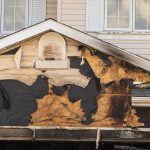Types of Storm Damage: Understanding the Impact on Your Home
From thunderous winds to relentless rain, storm damage takes many forms, each more menacing than the last. But fear not! BluSky is here to guide you through the turbulent world of storm damage, including what qualifies as storm damage and what to do if your home is threatened by it.
Water Damage
The most damaging result of storm damage is water damage because it can lead to significant structural and mold problems. Though water damage can be caused by any number of misfortunes like burst pipes and everyday leaks, it is often associated with severe weather like tropical storms and hurricanes. Depending on the storm’s severity, a hurricane could result in over 40 inches of rainfall in a single day!
Water damage can occur when your doors and windows aren’t properly sealed or when your roof shingles are damaged. This is why it’s important to invest in a quality roof inspection once every two or so years to ensure your shingles are up-to-snuff. Otherwise, they run the risk of water damage during the next storm.
Wind Damage
Wind damage is another common type of residential storm damage that impacts the majority of the United States. Average wind speeds usually teeter between six and 12 miles per hour; however, severe winds (anything over 58 miles per hour) can wreak havoc on anything in its path, including homes, cars, power lines, and trees.
The biggest problems that homeowners face during severe windstorms are trees and powerlines falling on the home, as well as shingles and siding blowing away. Since severe winds are usually accompanied by a hurricane or severe thunderstorm, the loss of shingles or siding often results in water damage in your attic or top floor.
Hail Damage
Like wind damage, hail is a natural weather occurrence that can cause severe damage to homes, cars, and commercial properties. Hail occurs when raindrops freeze, most commonly during a thunderstorm; however, it can also form during a tornado.
Since hail comes in a variety of sizes, ranging from the size of a pea up to a grapefruit, it can cause significant damage to your roof and crack windows, sliding glass doors, siding, and gutters, leading to costly repairs and replacements. Though hail can be disastrous on its own, it is exacerbated when combined with strong winds.
Lightning Damage
According to the National Weather Service, the average person has about a 1 in 15,300 chance of being struck by lightning in their lifetime; however, the chances of a home being struck by lightning are much higher. Though proactive steps such as using surge protectors and shutting off electronics and appliances during thunderstorms can help mitigate lightning damage, the risk persists.
Lighting damage can be extremely dangerous, as it can lead to fire and smoke damage, charring, electrical issues, and fried appliances. Additionally, tall trees are often targets of lightning strikes, posing a hazard to homes situated beneath them.
Ice and Snow Damage
Snow may be pretty to look at, but it can cause a wide range of household issues, not limited to water damage, gutter damage, foundation damage, and even mold damage.
Just like rainwater, melting snow can lead to water damage in all the same areas that would normally be affected, including your roof, windows, crawl space, and foundation. If left untreated, melting snow (like water) can lead to mold growth.
If snow sits inside your gutter for too long, the weight could cause your gutter to come down, requiring a replacement. Likewise, when melting snow gets near your home’s foundation, it could cause small cracks, which will be costly to repair.
Ice (snow’s damaging cousin) can lead to just as many issues, including frozen gutters and water damage. When a gutter is frozen, it’s unable to move water freely, forcing it to seep in and around your home’s foundation, leading to the issues mentioned above. In other words, ice and snow can be a homeowner’s nightmare!
Tornado Damage
Whether you live in Tornado Alley or not, you’re likely familiar with the mass destruction a tornado can cause in its wake. It’s important to note, however, that though tornadoes are most common in the central plains, they can actually occur in any U.S. state. As such, you should be armed with the knowledge of what to do in the event of a tornado, as well as what kind of damage is likely to result from it.
With wind speeds ranging from 65 to 200 miles per hour (or more), tornados can rip apart homes, damage roofs, and shatter glass doors and windows. Tornadoes can also uproot trees, which may fall over onto your property, further damaging what wasn’t damaged by the high winds.
What to Do Following Storm Damage: 3 Steps
Though no two types of storm damage are exactly alike, the protocol you’ll follow after them is similar. Here’s a brief overview of what to do following residential storm damage.
1. Ensure Everyone’s Safety and Check for Hazards
The types of storm damage mentioned here can be quite severe, so the first thing you want to do is check on everyone’s safety. Ensure everyone in your household is accounted for, and contact the authorities if you’re in need of emergency assistance.
When it’s safe to walk around your house or outside, be wary of broken glass, exposed wires, downed power lines, leaking gas lines, and broken items to avoid injury.
2. Take Photos of the Storm Damage
Documenting is an integral part of the storm damage checklist. Take photos of structural damage, such as broken doors and windows, fire damage, mold, debris, uprooted trees, and anything else you think is pertinent.
Remember, there’s no such thing as having too much evidence. The more photos you have of the damage, the easier it’ll be to handle your insurance claim.
3. Call a Storm Damage Restoration Professional
Severe storm damage is typically not a DIY project. Oftentimes, storm damage can lead to major structural damage and even health risks like mold growth. To ensure your home is restored quickly and safely, it’s best to contact a storm damage restoration professional.
Not only will they have the tools and knowledge needed to treat storm damage and help restore your home to what it was, but they will also have compassion in doing so. Storm damage can leave a path of destruction, sometimes costing you your home and everything in it. That’s why entrusting your storm damage restoration to a professional who understands how serious the matter is goes a long way in your overall experience.
Get Professional Storm Damage Repair With BluSky!
The industry experts at BluSky know a thing or two about storm damage repair. Known for our commitment to excellence, we are here to help you with every step of the storm damage restoration process, even as it pertains to your insurance claim.
We’re proud to offer a fast and reliable solution when the unexpected happens. Contact us today at 800-266-5677 to speak with a member of our team or find BluSky restoration near you. With BluSky, help isn’t just on the way – it’s here.


